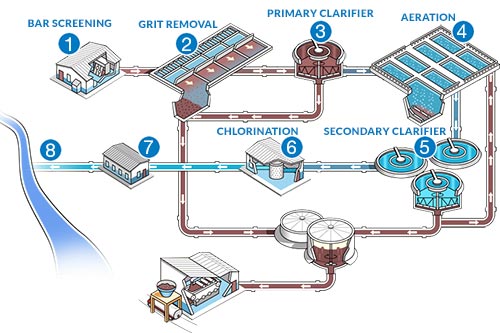How Wastewater Treatment Will Enhance Resource Reuse Opportunities
How Wastewater Treatment Will Enhance Resource Reuse Opportunities
Blog Article
Understanding Wastewater Treatment Processes and Their Ecological Impact
The details of wastewater treatment processes play an essential role in mitigating ecological challenges connected with water air pollution. Each phase, from initial to innovative treatments, is developed to attend to details impurities, ultimately protecting both public health and wellness and marine communities.
Review of Wastewater Therapy
Just how is wastewater changed right into a safe resource for the environment? Wastewater treatment is an essential procedure made to get rid of contaminants from used water, thus securing public health and protecting communities. This process begins with the collection of wastewater from residential, industrial, and industrial resources, which is then directed to therapy centers.
At these centers, numerous physical, chemical, and organic techniques are utilized to treat the wastewater. Ultimately, organic treatments, such as triggered sludge processes, use bacteria to break down organic matter.
The dealt with effluent can be safely discharged into all-natural water bodies or reused for irrigation and commercial objectives, promoting source preservation. Additionally, the treatment procedure creates biosolids, which can be repurposed as fertilizers or soil modifications, further improving sustainability.
Phases of Treatment Processes
The wastewater therapy procedure normally includes three main phases: preliminary, main, and second treatment. Each stage serves an unique duty in reducing the pollutant tons and making sure the effluent fulfills environmental requirements before discharge.

The main treatment stage concentrates on the physical separation of put on hold solids from the wastewater. Via sedimentation, larger particles settle at the bottom of sedimentation storage tanks, creating sludge, while lighter materials, such as oils and greases, float to the surface and are skimmed. This process substantially lowers the natural and not natural lots in the wastewater.
Second treatment is a biological process aimed at additional reducing the concentration of natural matter. This stage is important for achieving the required biochemical oxygen need (BODY) decrease, eventually leading to cleaner effluent prepared for discharge or additional therapy.

Advanced Therapy Technologies
Following the secondary treatment processes, advanced therapy technologies play a crucial role in further boosting the quality of treated wastewater. These modern technologies are developed to get rid of residual impurities that are not properly removed throughout primary and additional treatments, guaranteeing the effluent meets rigorous regulatory requirements.
Amongst the extensively used advanced therapy approaches are membrane filtering, reverse osmosis, and advanced oxidation processes. Membrane layer filtration, including microfiltration and ultrafiltration, works in dividing great particles, microorganisms, and colloids from the water (Wastewater). Reverse osmosis makes use of semi-permeable membrane layers to remove dissolved solids, leading to high-grade water suitable for different applications
Advanced oxidation processes (AOPs) utilize solid oxidants to degrade organic pollutants, including pharmaceuticals and personal treatment items that are immune to standard therapy. These methods enhance the biodegradability of complex compounds, facilitating their removal.
One more considerable innovation is making use of organic nutrient elimination procedures, which especially target nitrogen and phosphorus, protecting against eutrophication in obtaining water bodies. Overall, advanced treatment technologies are vital for accomplishing greater degrees of purification, promoting water reuse, and protecting public health and wellness while attending to the difficulties connected with wastewater administration.
Environmental Benefits of Treatment
Numerous ecological advantages arise from reliable wastewater therapy procedures that contribute to ecosystem health and wellness and sustainability. Mostly, these processes substantially minimize the release of dangerous toxins right into all-natural water bodies, which assists preserve aquatic look at these guys environments. By eliminating pollutants such as heavy metals, nutrients, and pathogens, treated wastewater mitigates the risk of waterborne diseases and advertises biodiversity in aquatic atmospheres.
Furthermore, wastewater treatment centers usually use innovative innovations that allow water recycling and reuse. This method not only conserves fresh water sources however likewise reduces the demand on all-natural water products. Improved nutrient removal from wastewater can additionally protect against eutrophication, a procedure that causes algal flowers and subsequent oxygen exhaustion in aquatic systems.
Furthermore, effective treatment procedures can reduce greenhouse gas emissions, especially methane and laughing gas, which are frequently released during unattended wastewater decomposition. By recording and using biogas from anaerobic digesters, centers can transform waste visit this site into renewable resource, consequently contributing to a reduction in nonrenewable fuel source dependency.
Difficulties and Future Fads
While the environmental benefits of wastewater therapy are clear, several difficulties linger that prevent optimal results in this area. One significant issue is aging facilities, which often results in inadequacies and increased operational expenses - Wastewater. Lots of therapy plants were designed decades back, and their capacities do not straighten with modern demands, which include stricter regulative criteria and greater quantities of wastewater due to urbanization

Looking in advance, there is a growing emphasis on source recuperation and circular economic situation concepts within wastewater treatment. Innovations such as anaerobic food digestion, which can create biogas, and advanced filtering technologies are obtaining grip. These methods not just improve treatment efficiency yet likewise promote sustainability.
Inevitably, resolving these difficulties requires cooperation among stakeholders, investment in innovation, and a commitment to ongoing research study. By embracing these fads, the wastewater treatment sector click can advance to satisfy the demands of a transforming environment and culture.
Conclusion
In verdict, wastewater treatment procedures play a vital function in improving ecological high quality and public health. The multi-stage therapy framework, paired with sophisticated technologies, successfully reduces air pollution and promotes sustainable water monitoring. By dealing with recurring contaminants and decreasing nutrition drainage, these processes add to the conservation of water ecological communities and the reduction of greenhouse gas exhausts. Continued improvements and adaptations in treatment techniques will certainly be necessary for conquering arising challenges and making certain the sustainability of all-natural resources (Wastewater).
Report this page